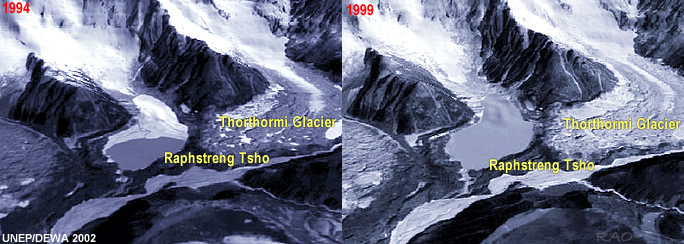| Bhutan's
glaciers and glacial lakes |
 |
Bhutan Glaciers - Glacial Lakes |
|
 |
Bhutan Glaciers - Glacial Lakes |
|
|
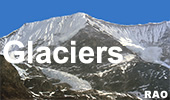 |
|
Decline of World's Galciers expected to have Global Impacts over this Century |
The
great majority of the world's glaciers appear to be declining at rates
equal to or greater than long-established trends, according to early results
from a joint NASA and United States Geological Survey (USGS) project designed to provide a global assessment of glaciers. At the same
time, a small minority of glaciers are advancing.
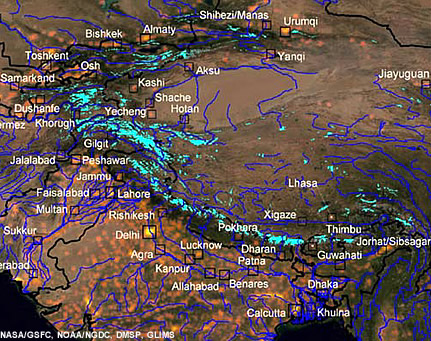 |
Towns
and Cities Affected By Melting Glaciers
This
is a "Blue Marble" image from NASA, "Earth at night" is superimposed on
this (NASA/GSFC), Using the lights as an indication of population density.
The squares on the map highlight a representative number of cities within
the regions of glacier-fed areas. All of these areas derive some benefit
from melting glaciers. The implication is that if the glaciers melt away
completely, or substantially, these areas would be affected.
 |
 |
External
link |
|
|
Jeff
Kargel, a USGS scientist who will discuss glacier changes and their potential
political and economic impacts at the American Geophysical Union (AGU)
Spring Meeting in Washington, suggests that accelerating climate change
over the next century will directly impact the rate that glaciers retreat.
The
research is part of an international effort by glaciologists, coordinated
by the USGS, which uses NASA satellite imagery to map and assess glaciers
throughout the world during the middle to latter part of the melt season
when
permanent ice is exposed.
Current
glacier satellite images are being compared with topographical maps and
other records of glaciers from the 20th century. The project, called the Global
Land Ice Measurements from Space (GLIMS), includes more than 100 collaborators
in 23 countries.
"Glaciers
in most areas of the world are known to be receding," said Kargel, who
is also the international coordinator for GLIMS. "But glaciers in the Himalaya
are wasting at alarming and accelerating rates, as indicated by comparisons
of satellite and historic data, and as shown by the widespread, rapid growth
of lakes on the glacier surfaces."
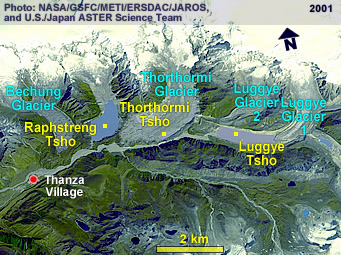 |
Glacial
Lakes From Melting and Receding Glaciers
This
composite image from the ASTER (Advanced Spaceborne Thermal Emission and
Reflection Radiometer) instrument aboard NASA's Terra satellite shows how
the Gangotri Glacier (India) terminus has retracted since 1780. Glacial
lakes have been rapidly forming on the surfaces of debris-covered glaciers
worldwide during the last few decades.
IMAGE
COURTESY: Jeffrey Kargel, USGS / NASA JPL / AGU
 |
 |
External
link |
NASA
ASTER
|
|
While
ice reflects the sun's rays, lake water absorbs and transmits heat more
efficiently to the underlying ice, kicking off a feedback that creates
further melting.
According
to a 2001 report by the Intergovernmental Panel on Climate Change,
scientists estimate that surface temperatures could rise by 1.4°C to
5.8°C by the end of the century. The researchers have found a strong
correlation between increasing temperatures and glacier retreat.
Glacier
changes in the next 100 years could significantly affect agriculture, water
supplies, hydroelectric power, transportation, mining, coastlines, and
ecological habitats. Melting ice may cause both serious problems and, for
the short term in some regions, helpful increases in water availability,
but all these impacts will change with time, Kargel said.
For
example, the Gangotri glacier between Kashmir and Nepal is retreating
at an accelerated rate that cannot be accounted for by lingering effects
from warming after the little ice age over 200 years ago. The Gangotri
glacier-and many others-feed the Ganges River Basin, upon which hundreds
of millions of people, including those in New Delhi and Calcutta, depend
for fresh water.
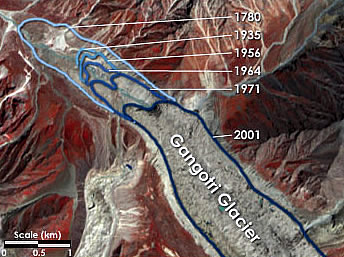 |
The
Gangotri Glacier, India: Last 200 Years
This
composite image from the ASTER (Advanced Spaceborne Thermal Emission and
Reflection Radiometer) instrument aboard NASA's Terra satellite shows how
the Gangotri Glacier (India) terminus has retracted since 1780. Contour
lines are approximate.
(Image
by Jesse Allen, Earth Observatory; based on data provided by the ASTER
Science Team; glacier retreat boundaries courtesy the Land Processes Distributed
Active Archive Center)
|
|
Kargel
finds that over one percent of water in the Ganges and Indus Basins (South
Asia) is currently due to runoff from wasting of permanent ice from glaciers.
This contribution is expected to increase as melting rates accelerate,
though ultimately the added runoff is predicted to disappear as glaciers
decline many decades from now. Such changes are important since water use
in these basins is already approaching capacity as populations continue
to grow. In drier parts of Asia, like in arid Western China, wasting glaciers
currently account for over ten percent of fresh water supplies.
But
the research finds positive aspects to glacier changes as well.
"It's
not all doom and gloom," Kargel said. "Glaciers are wastelands, but as
they recede the land underneath may become available for use."
The
net loss or benefit of receding glaciers has not been calculated, but Kargel
suspects the overall impacts will be negative.
GLIMS
is designed to monitor the world's glaciers primarily using data from the ASTER
(Advanced Spaceborne Thermal Emission and reflection Radiometer) instrument
aboard the NASA's Earth Observing System (EOS) Terra spacecraft,
launched in December 1999.
May
29, 2002
AGU
Press
|
more
information
|
 |
 |
 |
External
link |
|





